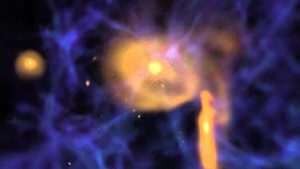
Hubble Space Telescope To Find Early Galaxy Formations Under New Observing Campaign
To help astronomers to understand the distribution system of galaxies of the early universe better along with the conditions that led to their formation, Hubble Space Telescope has begun a new campaign, the US space agency has said.

Called as Beyond Ultra-deep Frontier Fields and Legacy Observations (BUFFALO), the new observing campaign will help in observing six large galaxy clusters along with their surroundings, less than 800 million years ago after the big bang, Nasa said.
It further said that Abell 370 is the first such cluster to be observed.

The first such observations made by Hubble telescope shows that the galaxy cluster called as Abell 370 is along with another host of magnified, gravitationally lensed galaxies around it.
As of now, Abell 370 is located somewhat 4 billion light-years from the Earth and is situated in the constellation Cetus – popularly known as the Sea Monster.
The 101 Hubble orbits, which corresponds to 160 hours of precious observation time, have been dedicated to enabling it to explore the six Frontier Field galaxy clusters, the ESA said.
The BUFFALO survey being conducted will also take an advantage of many other space telescopes which have already observed all of the regions located near the clusters. The search for first galaxies will include these datasets.
According to the astronomers, the new survey will help in yielding new insights into the question of when the most massive and luminous galaxies were formed and how they are linked to dark matter and the cluster’s dynamics influence the galaxies in and around them.
The survey will also help provide a chance to pinpoint those images of distant galaxies and supernovas.
To determine the speed of formation of the galaxies in less than 800 million years soon after the big bang will help astronomers to come up with a design of strategies to use NASA’s upcoming James Webb Space Telescope to enable the probe of distant universe with its infrared vision, NASA said.
The project BUFFALO is designed to succeed the successful Frontier Fields project and was led by European astronomers from the Niels Bohr Institute (Denmark) and Durham University (UK).
The project involves an international team of a total 100 astronomers from 13 different countries.
Space exploration has been man’s dream right from ages, but due to the advanced technologies, it has become very easy now to explore the universe from any angle.
You May Also Read: Hate Speech Detection On Social Media Sites By Artificial Intelligence Can Easily Be Fooled